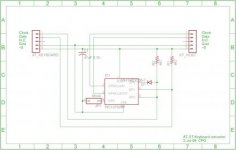Hi Guys,
I got the AT2XTKBD circuit board some time back in the hopes of converting my XT Keyboard for use with my PC visa PS/2. I had understood that of course the code for the PIC needed to be changed as i had planned to use it the opposite of what it was intended for.
After looking at the code i realized that a whole LOT more needs changing besides the translation lookup table for the scan codes. Like for example the functions processing the signals from the host were all done assuming that the host was an XT computer, and the functions processing the input from the keyboard were assuming that from a AT Keyboard.
From looking at the AT2XTKBD.sch diagram, my idea was to hook up the PC to the current "PS/2_Keyboard" port and the XT keyboard to the "XT_HOST" port. And re code the code for the adapter. Is this feasible (hardware wise)?
Next thing i can't figure out is what is the purpose of Jumper 1?

I think before i attempt this i need to understand more on how a AT host, and a XT keyboard behaves. Can someone please point me to some documentation on these? I seem to easily find docs for AT keyboard but not much is found for XT Keyboard.
Thanks!

